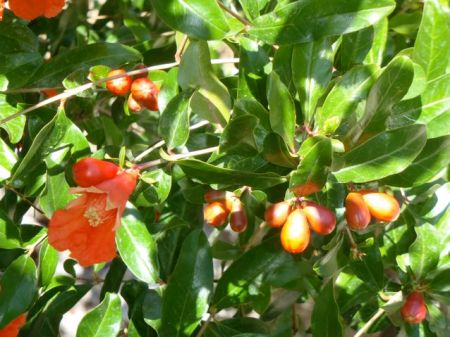More tales of village life.
At the back of this little house is the, oft mentioned, donkey track that leads down into the rest of the village. Since the house next to us is deserted and the house opposite derelict the track gets little traffic. During the summer months tourists wander up it from time to time and then turn back when they discover that it leads to a dead end.
Ever since we moved in we have had an eye on that dead end; the track opens out into a space about 15 feet by 15 feet, overlooked by our kitchen window but otherwise entirely private. It isn’t our land, the title deeds are perfectly clear on that, but it’s a lost space and no one uses it and it’s been entirely unloved. Our vague plan when we bought the house was that we’d clear the space and put tables and chairs out there along with some plants in containers. Then, if anyone ever complained at our colonisation we could undo things.

The hidden garden, from above
Until now that plan has been on hold. The house had to be the first priority and the walled garden close behind. There was also another reason for holding back: we wanted to have some time in the house to understand how the light and the sun impact the walled garden and the potential second space. No point putting sunbeds there if it never got the sun. We learnt quickly that full sun is as welcome in winter as hard shade is in the height of summer.
Well, a year on we now know that in winter it rarely sees the sun. It is east-facing and the surrounding stone walls are high on several sides so in the short light of the winter months it is a cold and damp place, so much so that moss and lichen become a problem on the donkey track.
In summer it gets the afternoon sun but because of the height of the walls it stays much cooler than the garden. Just the place to retreat to on a sweltering summer’s afternoon.
But, apart from the project to clear the area there is another issue: the area is bordered on two sides by a derelict house and an empty plot. On their own they wouldn’t be a huge problem, all are built of fantastic Lefkara limestone and look beautiful. The issue is that the weeds have been allowed to grow unchecked and combined with the occasional discarded household appliances the plots look distinctly unappealing to humans. To rats however they are an ideal home. We’ve seen them running through these plots unchecked. The term rat run is all too appropriate.

Anyone need a spare water tank?
So, the potential is there for a lovely hidden secret garden to sneak off to on hot summer days but for the ten foot high weeds and local rat population in parts of the village over which we have no control.
Our only other fellow Brit in the village, Gerry the antique-collector, lives on the other side of these plots. Via the donkey track it’s a good 5 minute walk to his house from ours or 30 seconds as the crow flies. Since we mentioned the rodent problem he has become aware that he, too, is hearing the nocturnal patter of rodent feet across his roof. He has long wanted to buy the empty plot to get it cleared and improve the look of the area around his house. However despite his best efforts he, and the previous English owner of his house, has been unable to find the details of the owner. His neighbours have always claimed that it would be impossible to buy as the land had been passed down according to Cypriot inheritance law and was probably now owned jointly by a dozen or more heirs. To buy would mean getting each to agree to sell their 1/12th share.
This week Gerry declared war on the rats and weeds. If the mysterious missing owners would do nothing about the plot then he’d take charge, he said. He would pay for the land to be cleared and when it was done he might put a chair or two in there. This morning we woke to the sound of someone strimming and chopping and hauling ancient water tanks out of the area. We assumed that this was Gerry’s doing and it turns out that, indirectly, it was.
This afternoon he stopped by to gloat; he hadn’t paid for the area to be cleared, the owners had. Apparently the village grapevine had been activated and word had got back to the owner (just one, the story of a dozen heirs seems not to be true) that a mad Brit was planning a land-grab. Horrified by such an idea the owner decided to take preemptive action and get things cleared so there was no further cause for complaint.
The work is not yet finished but already the area is looking distinctly better and, hopefully, less appealing to the local rodent population. We might just get our secret garden this summer after all.



































